page 38
Note: the contents of this page as well as those which precede and follow, must be read as a continuation and/or overlap in order that the continuity about a relationship to/with the dichotomous arrangement of the idea that one could possibly talk seriously about peace from a different perspective as well as the typical dichotomous assignment of Artificial Intelligence (such as the usage of zeros and ones used in computer programming) ... will not be lost (such as war being frequently used to describe an absence of peace and vice-versa). However, if your mind is prone to being distracted by timed or untimed commercialization (such as that seen in various types of American-based television, radio, news media and magazine publishing... not to mention the average classroom which carries over into the everyday workplace), you may be unable to sustain prolonged exposures to divergent ideas about a singular topic without becoming confused, unless the information is provided in a very simplistic manner.
Let's face it, humanity has a lousy definition, accompanying practice, and analysis of peace.
One of the big issues confronting those analyzing the Peace/War dichotomy within the parameters of the present discussion, is the presence of so many two-patterned examples... and yet there are some very important three-patterned forms and functionalities which appear to go hand in hand as well as present us with a dilemma. For example, if we can find patterns-of-two in some very basic structures of biology, anatomy and physics, why then the need for any other pattern, unless to suggest a developmental, if not evolutionary trend? For example, why create life forms beyond a one-Germ layer? And why stop at three? And though one may suggest the need for a "neutral" between positive and negative, do we have only two eyes, ears, brain hemispheres, legs, etc., or is there an unrecognized third entity like some people describing the usage of their mouth as a third hand, or that the "mind's eye" is the third eye, or that some people like musicians have a third ear? But let us begin this short essay portion by providing a bit of elementary biology which discusses the development of life from the single (cellularity) to the complex, (with both the simple and complex structures relying on a triplet coding genetic system and the placement on a watery third planet from a source of solar energy):
Diversity Prokaryotes and eukaryotes All bacteria are prokaryotic, even though many, probably most, are multicelled in nature. The only other single-celled organisms that exist are fungi (one-celled fungi are called yeasts). All nucleated organisms (cells with nuclei and chromosomes in their cells) that are not animals, fungi, or plants are Protista. This huge group includes the unicellular or few-celled protists and their multicellular descendants. The large kingdom of Protista has 250,000 estimated species alive today. Some are very large, such as red algae and the kelp Macrocystis. One-celled protists include the familiar amoebas, paramecia, and euglenas as well as 50,000 less-familiar types. Scientifically speaking, no such thing as a one-celled animal exists. All animals and plants are by definition multicellular, since they all develop from multicellular embryos. Accordingly, all "protozoans" are now classified as single-celled Protista, not animals. Nor are there any one-celled plants. Organisms formerly called one-celled plants are algae and, as such, are now classified with Protista as well. If a mature organism is determined to be one-celled, then it must be either a bacterium (prokaryotic) or a fungus or protist (eukaryotic). All animals and plants develop from embryos that by definition combine two complementary sets of chromosomes (i.e., they are diploids at some stage in their development). They are all multicellular eukaryotes. But though there are no one-celled plants or animals, there are indeed myriad many-celled protists. Multicellularity evolved not only in the ancestors to the plants and the animals but also in the bacteria, the protists, and the fungi. All eukaryotic cells undergo some form of mitosis, a sequence of cell division events that occurs after chromosomal DNA protein replication. Mitosis ensures that chromosomal DNA and protein are equally distributed to the offspring cells. Mitosis is the most distinctive activity of eukaryotic cells, which have nucleoprotein chromosomes in their nuclei and a membrane that separates the nucleus from the cytoplasm. In mitosis, mitochondria, which are usually present in the cytoplasm as well as in the chloroplasts of algae and plants, are smoothly distributed with the chromosomes to offspring cells. The Golgi apparatus and endoplasmic reticulum (ER), an intricately convoluted structure, serve to anchor many cytoplasmic enzymes excluded from mitochondria or chloroplasts. They also divide and are distributed in mitosis. Nuclei, chromosomes, mitochondria, chloroplasts, ER, and nuclear membranes are all absent in prokaryotes. Prokaryotic cells, which include all the cyanobacteria (formerly called blue-green algae), are bacteria in every way. Division is nonmitotic in all prokaryotes. Bacteria lack nucleoprotein and a nuclear membrane, and, when chromosome stain is applied, only fuzz or nothing is seen. Whereas all eukaryotic cells have more than one chromosome and sometimes over a thousand, the genes of prokaryotic cells are organized into a single "chromoneme" or "genophore." (The term bacterial chromosome, while still in use, is, technically speaking, inaccurate.) The genes may or may not be concentrated enough to be seen, but in any case bacterial DNA floats freely in the cytoplasm. Prokaryote cell organization is less complex than that of eukaryotes. The basic question of the evolution of prokaryotes into eukaryotes—often rated the second major evolutionary mystery, after the origin of life—is thought to involve a complex series of partnerships in which distinct strains of bacteria entered each others' bodies, merged symbiotically, and traded genes. Multicellularity Since multicellularity evolved independently in every major group of microorganisms, the blurred distinction between single-celled and many-celled organisms has become obsolete. The protists are divisible into about 35 unambiguous groups called phyla. They provide many examples of biological principles—including the prevalence of independent trends toward multicellularity. One illustration involves cellular slime molds. These heterotrophs undergo an extraordinary sequence of events during their life history. The story begins with single cells, indistinguishable from common amoebas. When starved, they begin to swarm. Soon they combine into a slimy mass of many nucleated amoeba cells called a pseudoplasmodium. The pseudoplasmodium in turn forms a sluglike multicellular creature resembling a mollusk that has escaped from its shell. This slug, which is entirely multicellular, migrates and then stops and develops into a stalk structure called a sorocarp that bears amoeba cysts on top. The cysts were called "spores." Some have cellulose cell walls similar to those of plants. The cysts, which are encased amoebas (just like other amoeba cysts), germinate in turn—when water and food again become abundant—into new amoebas. The released amoebas extend their pseudopods, and, as individuals again, they migrate to feed. The life history repeats with swarms of migrating amoebas, slugs, stalks, and finally clusters of amoeba cysts on top as wet, food-rich conditions are followed by dryness and scarcity. Biology is replete with life histories of comparable or even greater complexity. In protist life histories—by far the most diverse, exotic, and unique—one can search for ancestral modes of life, including missing links between the prokaryotes and eukaryotes. The one-celled swimming stage is called a sperm, whose imperative it is to find another one-celled partner, the ovum. Like all animals, humans develop from a single fertilized egg with its complement of two sets of genetic material. These diploid fertilized egg cells then divide to form many presumably identical cells. The early embryology of all animals goes through stages that have 2, 4, 8, 16, and so on cells. Genetic information is theoretically identical in each cell. But then how does it ever happen that, as they mature, the cells become permanently specialized to form hair, bone, liver, blood, or nerve cells? How does any given cell "know" what sort of specialized cell it must become, since all cells seem to contain identical nucleic acids? Despite a century of work on this process (called differentiation) and the discovery of many facts about embryos, this basic problem still remains unsolved in animal biology. The improbability of contemporary organisms...is so great that these organisms could not possibly have arisen by purely random processes and without historical continuity. Fundamental to the genetic definition of life then seems to be the notion that a certain level of complexity cannot be achieved without natural selection. |
Note: The (political/economic/commodity) 'starvations' of the French stirred a (1789) Revolution but the starving of the Irish during the Potato Famine did not (perhaps because it was the wrong kind of starvation and that different kinds of starvation produce different effects). Hence from this, one might venture to suggest that the above example may also not fit well into the life history of all life forms as a condition which spurs development... or that the development is of great value since its origins are one of deprivation... a situation it may intentionally seek out in an attempt to foster further growth.
Yet, in suggesting a "natural selection", do we care to suggest that the peace/war dichotomy is the product of some deprivation or due to unrealized conditions which keeps the dichotomy "alive" (viewed as an organism that can replicate from one generation to the next)? Is this thing which is called "natural selection" identifiable on a basic (pattern) level from the type of life-forms which are produced (single-celled/ multi-celled)? Are we mistaking the overall results of a process for a pattern? Why does the peace/war "organism" remain as a diploid (dichotomous) character and not evolve into some articulated mental complexity? What is sustaining the dichotomy if its present recurring existence is not being sufficiently "fed" in order that it doesn't experience a deprivation allowing it to evolve into a multi-cellularity... so to speak?
No less, "Replication", in a sense... is mirror-imaging. It's like a reflection that is manifested into an actual form... like a shadow that becomes a real person as a wooden puppet that changes into a real boy as described in the story of Pinocchio.
When we recognize that a cell doubles from a singularity to a double (dipolid) and in many cases continues to double (4, 8, etc...), we must note that the "4" represents the third event and that replication does not take place past the "two" stage. In other words, the sequence is not 1 + 1 = 2, 1 + 2 = 3, 2 + 3 = 5, etc... Nor does the doubling take place by threes (3 + 3 = 6, 6 + 6 = 12, etc...), nor that there is an absence of a tripling (or other) sequence (3 + 3 + 3, 9 + 9 + 9, etc...), even though multiple hundreds of replications may take place every second. In other words, there is a conservation of number. Something in the environment is telling cellular activity to remain at the "two" stage of replication just like something is telling certain cells to differentiate into hair, nails, teeth, fingers, toes, eyes, brain, etc...
Whereas there may be mutagenic instances where an organism may be born with multiple heads, three-headed people don't appear to be viable... but two-headed people can be and single-headed people are. Yet, the basic pattern of brains appears to be the existence of having two hemispheres, partitions or lobes amongst mammals and insects, and one might even venture to claim exists in plants when we cite the Venus fly trap (which by the way using three specialized hairs on each lobe which are used as signaling devices for the lobes to close when stimulated by an insect. The three shown in the picture below appear to be arranged in a triangular fashion.)
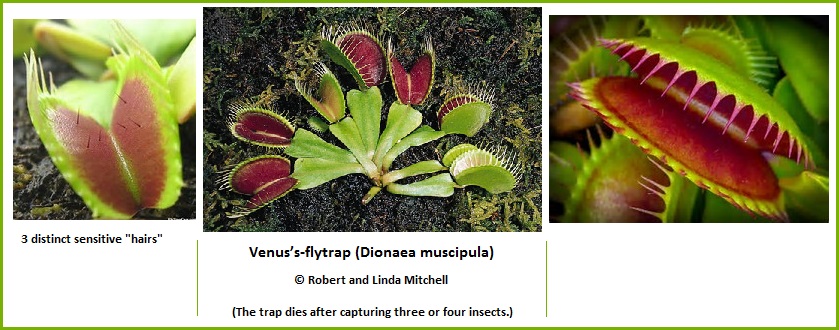
The triangular or "Y-shaped" configuration of the three sensitive hairs on the predatory plant Venus needs to be followed up with some more examples of this pattern. Note that antibodies and immunoglobulins are "predatory" just as is the 3-pronged, Y-shaped mouth of the Leech:
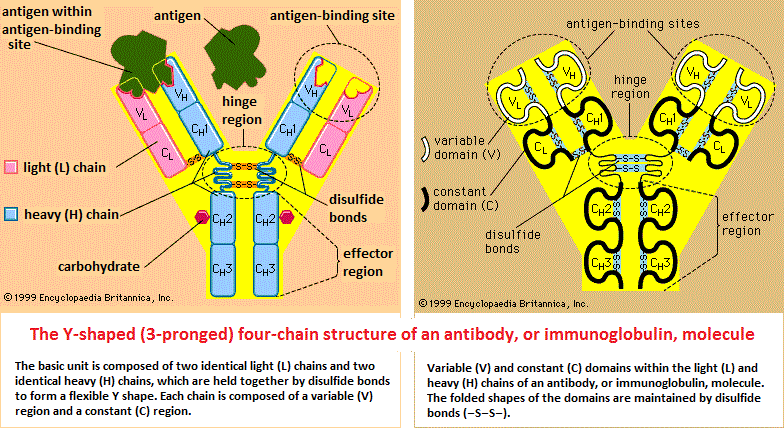
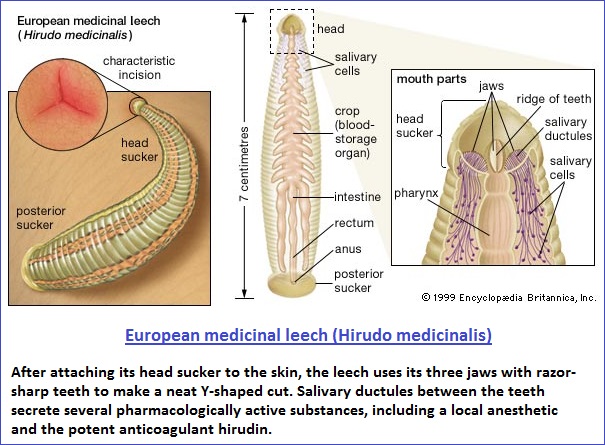
Science and Technology Posted by Daniel Stolte- Arizona, April 12th, 2013U. ARIZONA (US) / KING'S COLLEGE LONDON (UK) — Decision-making centers in the brains of insects and mammals share too many similarities to have evolved independently, a new study suggests. Published in Science, the findings point to deep similarities in how the brain regulates behavior in arthropods (such as flies and crabs) and vertebrates (such as fish, mice, and humans). Based on their own work and available literature, Nicholas Strausfeld, professor of neuroscience at the University of Arizona, and Frank Hirth of the Institute of Psychiatry at King's College London compared the development and function of the central brain regions—the "central complex" in arthropods and the "basal ganglia" in vertebrates. The brain of a praying mantis, one of the most dexterous of insects, possesses what is perhaps the most exquisitely structured central complex, revealing 9 distinct modules when visualized under a microscope. (Credits: Left - Charles Hedgcock (charles@charleshedgcock.com); right- Gabriella Wolff/UA Department of Neuroscience) 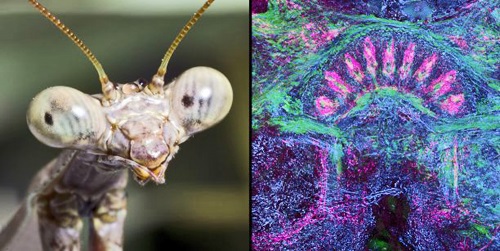 In humans, dysfunction of the basal ganglia can cause severe mental health problems ranging from autism, schizophrenia, and psychosis, to neurodegeneration—as seen in Parkinson's disease, motor neuron disease and dementia—as well as sleep disturbances, attention deficits, and memory impairment. When parts of the central complex are affected in fruit flies, they display similar impairments. (Credit: Katherine E. White & Dickon M. Humphrey, Hirth Lab/KCL) 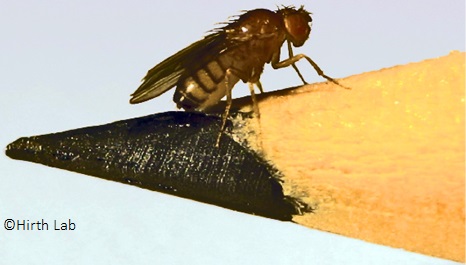 Their research suggests that both brain structures derive from embryonic cells at the base of the developing forebrain and that, despite the major differences between species, their respective constitutions and specifications derive from similar genetic programs. "When you compare the two structures, you find that they are very similar in terms of how they're organized," says Strausfeld. "Their development is orchestrated by a whole suite of genes that are homologous between flies and mice, and the behavioral deficits resulting from disturbances in the two systems are remarkably similar as well." Nerve cells in the central complex and the basal ganglia become inter-connected and communicate with each other in similar ways, facilitating the regulation of adaptive behaviors. In other words, the response of a fly or a mouse to internal stimuli such as hunger or sleep, and external stimuli such as light/dark or temperature, are regulated by similar neural mechanisms. "Flies, crabs, mice, humans: all experience hunger, need sleep, and have a preference for a comfortable temperature, so we speculated there must be a similar mechanism regulating these behaviors," says Hirth. "We were amazed to find just how deep the similarities go, despite the differences in size and appearance of these species and their brains." In humans, dysfunction of the basal ganglia can cause severe mental health problems ranging from autism, schizophrenia, and psychosis, to neurodegeneration—as seen in Parkinson's disease, motor neuron disease and dementia—as well as sleep disturbances, attention deficits, and memory impairment. When parts of the central complex are affected in fruit flies, they display similar impairments. "We know of many mutations in the central complex of insects that give rise to disruption in behavior," Strausfeld explained. "In one such mutation, the insects can walk in straight lines, but when they turn, they fall over their own feet. Taken together, these manifestations are very reminiscent of what happens in Parkinson's." The findings suggest that arthropod and vertebrate brain circuitries derive from a common ancestor already possessing a complex neural structure mediating the selection and maintenance of behavioral actions. Hirth adds that "the deep similarities we see between how our brains and those of insects regulate behavior suggest a common evolutionary origin. It means that prototype brain circuits, essential for behavioral choice, originated very early and have been maintained across animal species throughout evolutionary time. As surprising as it may seem, from insects' dysfunctional brains, we can learn a great deal about how human brain disorders come about." The findings add to an emerging picture of a common ancestor of invertebrates and vertebrates of deep in evolutionary time whose brain may have already been much more complex than many scientists are ready to admit. Other brain structures have revealed their common origins in previous research, such as the hippocampus in vertebrates and the mushroom bodies in arthropods. Source: Why are insect and human brains so similar? |
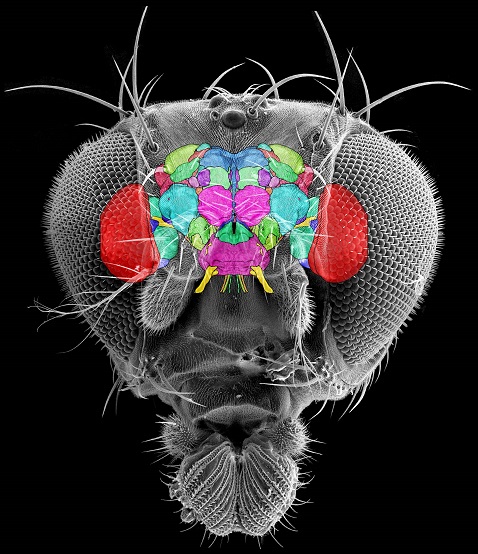 Source for fruit fly image: Researchers provide standardized nomenclature for the architecture of insect brains |
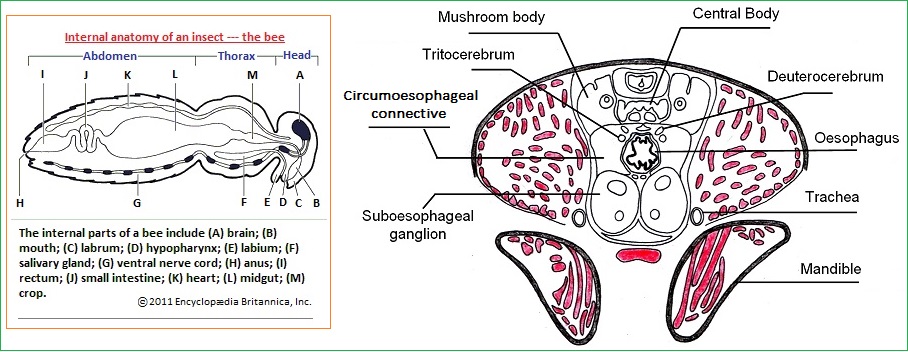 |
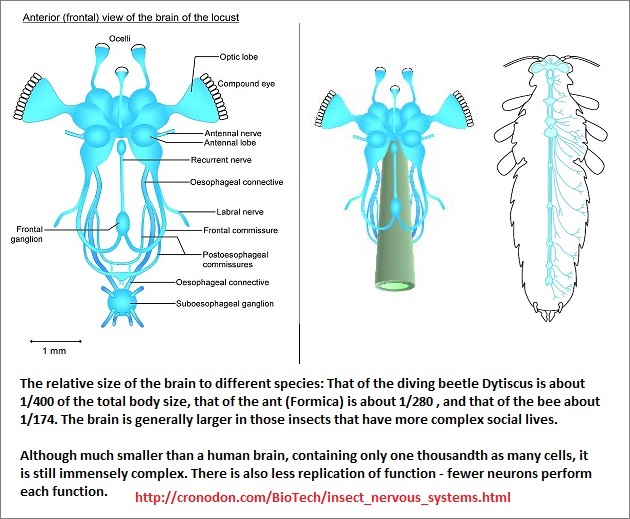 |
|
Flatworm also called platyhelminth(Flatworms are) any of the phylum Platyhelminthes, a group of soft-bodied, usually much flattened invertebrates. A number of flatworm species are free-living, but about 80 percent of all flatworms are parasitic—i.e., living on or in another organism and securing nourishment from it. They are bilaterally symmetrical (i.e., the right and left sides are similar) and lack specialized respiratory, skeletal, and circulatory systems; no body cavity (coelom) is present. The body is not segmented; spongy connective tissue (mesenchyme) constitutes the so-called parenchyma and fills the space between organs. Flatworms are generally hermaphroditic—functional reproductive organs of both sexes occurring in one individual. Like other advanced multicellular animals, they possess three embryonic layers—endoderm, mesoderm, and ectoderm—and have a head region that contains concentrated sense organs and nervous tissue (brain). Most evidence, however, indicates that flatworms are very primitive compared with other invertebrates (such as the arthropods and annelids). Some modern evidence suggests that at least some flatworm species may be secondarily simplified from more complex ancestors. With very few exceptions, platyhelminthes are hermaphroditic, and their reproductive systems are generally complex. Numerous testes but only one or two ovaries are usually present in these flatworms. The female system is unusual in that it is separated into two structures: the ovaries and the vitellaria, often known as the vitelline glands or yolk glands. The origin of the platyhelminths (parasitic or free-living worms having a flattened body) and the evolution of the various classes remain unclear. There are, however, two main lines of thought. According to the more widely accepted view, the Turbellaria (flatworms) represent the ancestors of all other animals with three tissue layers. Other authorities have agreed, however, that flatworms may be secondarily simplified; that is, they may have degenerated from more-complex animals by an evolutionary loss or reduction of complexity. Nervous system The main ganglia, or nerve centres, of the nervous system and the major sense organs are generally concentrated at the anterior end. Typically, the primitive brain of the flatworm consists of a bilobed mass of tissue with lateral longitudinal nerve cords connected by transverse connectives, thus forming a rather ladder-like structure or grid running the greater length of the organism. Free-living forms commonly have two longitudinal cords, but some tapeworms have as many as 10. Sensory receptors occur in all groups.  Musculature The well-developed muscular system present in flatworms is comprised of a sub-cuticular musculature consisting of layers of circular, longitudinal, and diagonal muscles close to the epidermis, and a mesenchymal musculature consisting of dorsoventral, transverse, and longitudinal fibres passing through the mesenchyme. In general, platyhelminths are capable of extensive body contraction and elongation. James Desmond Smyth: Emeritus Professor of Parasitology, London School of Hygiene and Tropical Medicine, University of London. Author of Introduction to Animal Parasitology.Source: "Flatworm." Encyclopædia Britannica Ultimate Reference Suite, 2013. |
As with insects and worms, we find a "two" division in the brain structures of different animals:
 |
 |
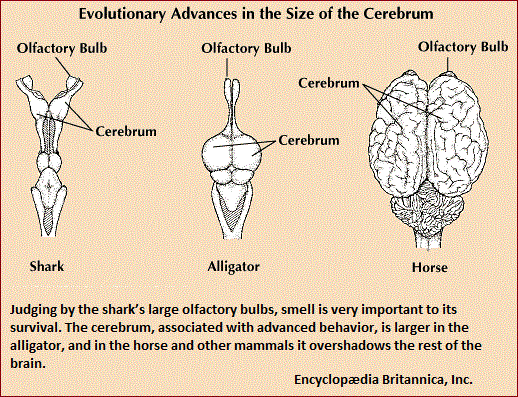
|
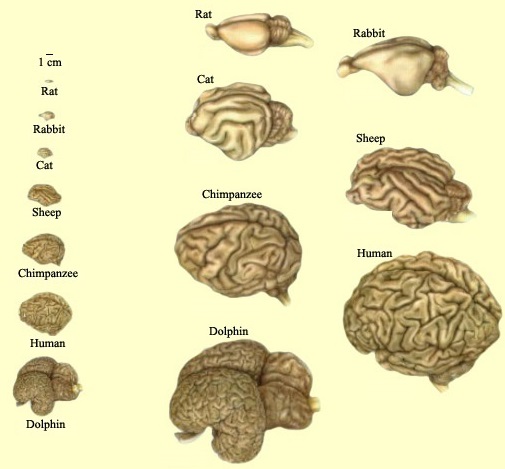 |
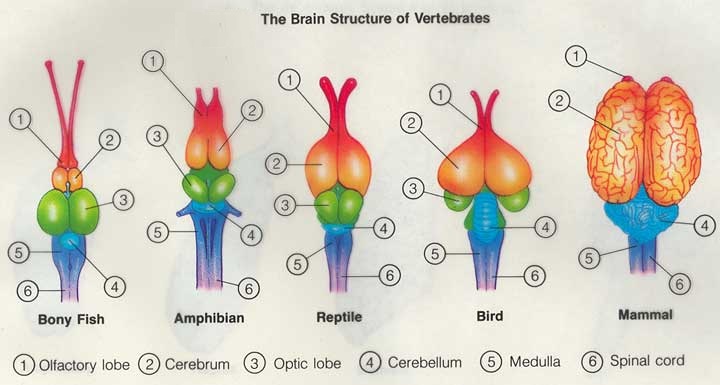 |
|
While we can recognize a "two" structure in biology such as for example organisms acquiring energy by two general methods: by light or by chemical oxidation, light/dark photosynthesis and aerobic/anaerobic life forms, etc.; there is a distinct usage of a "three" pattern with respect to development as well:
- The Universe is viewed as being flat, spherical or saddle (triangular)-shaped
- There are three laws of motion and three laws of planetary motion.
- There are three large nuclear particles: Protons- Neutrons- Electrons
- Each of the large nuclear particles are said to contain three quarks and three anti-quarks
- There are three families of fundamental particles: Stable, Unstable, Highly unstable
- Earth is the third planet from a source of Solar energy
- DNA and RNA have triplet coding systems
- There are three main sources for cellular energy: AMP, ADP, ATP
Cellular respiration consists of three metabolic processes: glycolysis, the tricarboxylic acid cycle (TCA cycle; also known as the Krebs, or citric acid, cycle), and oxidative phosphorylation (respiratory-chain phosphorylation).
- Blue & Green algae (procaryotic... producing increased oxygen atmosphere) → (followed by) red algae (first eucaryotic cells)
- Eukaryotic algal cells contain three types of double-membrane-bound organelles: the nucleus, the chloroplast, and the mitochondrion.
The effects of water on light absorption: Red wavelengths are absorbed in the first few metres of water. Blue wavelengths are more readily absorbed if the water contains average or abundant amounts of organic material. Thus, green wavelengths are often the most common light in deep water.
Chlorophylls absorb red and blue wavelengths much more strongly than they absorb green wavelengths, which is why chlorophyll-bearing plants appear green. The carotenoids and phycobiliproteins, on the other hand, strongly absorb green wavelengths. Algae with large amounts of carotenoid appear yellow to brown, those with large amounts of phycocyanin appear blue, and those with large amounts of phycoerythrin appear red.
At one time it was believed that algae with specialized green-absorbing accessory pigments out-competed green algae in deeper water. Some green algae, however, grow as well as other algae in deep water, and the deepest attached algae include green algae. The explanation of this paradox is that the cell structure of the deepwater green algae is designed to capture virtually all light, green or otherwise. Thus, while green-absorbing pigments are advantageous in deeper waters, evolutionary changes in cell structure can evidently compensate for the absence of these pigments.
The major carbohydrate storage product of the chromophyte algae and Euglenophyceae is formed from glucose molecules interconnected with beta linkages between the number 1 and 3 carbons.
In Algae, the inner membrane of the mitochondrion is infolded to a great extent, and this provides the surface area necessary for respiration. The infoldings, called cristae, have three morphologies: (1) flattened or sheetlike, (2) fingerlike or tubular, and (3) paddlelike. The mitochondria of land plants and animals, by comparison, generally have flattened cristae. (Britannica: algae)
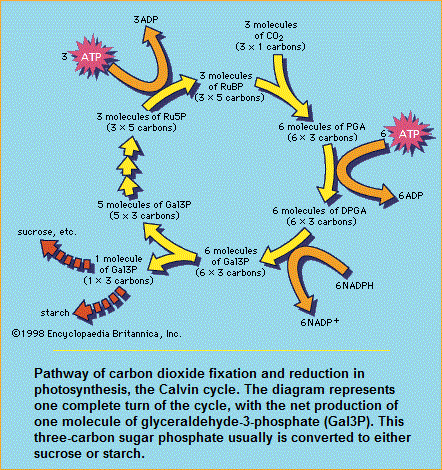
- Triplet (overlapping) microtubule structure: Bio/Physiological threes, page 1
- There are three life domains: Archaea, Bacteria, Eucaryota
- There are three Germ layers: Endoderm- Mesoderm- Ectoderm
- Threes in human anatomy: Dr. McNulty's Threes in Human Anatomy
With respect to the brain and the foregoing "two"-patterned examples, we can find a "three"-patterned being referenced to humans, in that there is a division of the two hemispheres into a two and three organization in terms of hemispheric attributions previously described on page 6 in this series:
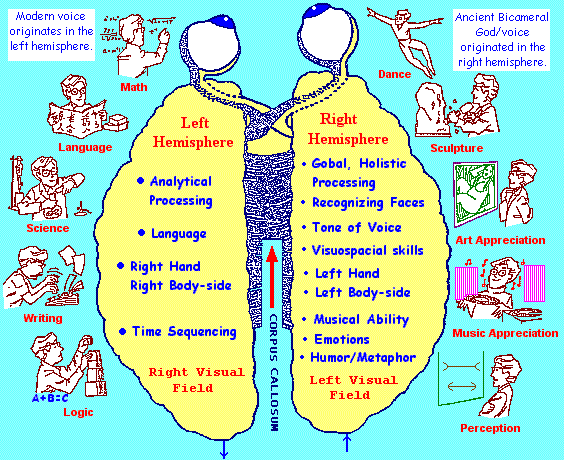
Note: Much of the brain illustration shown above was adapted from page 106 of Dean Falk's book entitled "Brain Dance," 1992.
An overall 3-patterned formula to brain hemisphere attributes can be recognized:
When we look at the assigned culturally recognized attributes of the brain, we can see a distinct (over-lapping) 1-patterned, or 2-patterned, or 3-patterned arrangement. (Reminder: when a person gets a stroke in the left hemisphere of the brain it affects the right side of the body, and vice-versa. Thus, the "2" and "3" patterns will appear to be reversed. It is an "X" or criss-cross pattern similar to that seen in vision, a cerebral stroke, the firing order of internal combustion engines and the stance of birds— though some might be able to imaginatively envision a type of figure-of-eight configuration:)
| Left
Hemisphere (Predominantly 3-patterned) Math: Associative~ Commutative~ Distributive A2 + B2 = C2 ~ Sine- Cosine- Tangent 1st# (+ - X /) 2nd# = 3rd# Logic: Thesis ~ Antithesis ~ Synthesis Indulgence ~ "Middle Way" ~ Asceticism Major Premise ~ Minor Premise ~ Conclusion Time Sequencing: Seconds~ Minutes~ Hours Past ~ Present ~ Future Day~ Week~ Month Language - Speech - Grammar: Subject~ Object~ Verb Consonants ~ Vowels ~ Supra-segmentals Period ~ Question Mark ~ Exclamation point Right Body Side: Tri-cuspid heart valve Three-lobed lung |
Right
Hemisphere (Predominantly 2-patterned) Holistic: Macro versus Micro Whole versus Part Inner versus Outer Music: Major Scale vs Minor Scale Loud versus Soft (Quiet) Consonance vs Dissonance Visuospatial: (Art) Background vs Foreground Light vs Dark (Contrasts) 1 Dimension vs 2 Dimensions Emotions: Pain versus Pleasure Positive vs Negative Love versus Hate Left Body Side: Bi-cuspid heart valve Two-lobed lung |
|
(Reptilian) (Predominantly 1-Patterned) (Self)-Preservation~ (Self)-Procreation~ (Self)-Preeminence | |
 The correlations of two and three being made on this page are not typical considerations. However, I did come across a single reference concerning the tricuspid valve: http://www.madsci.org/posts/archives/mar97/855255174.An.r.html | |
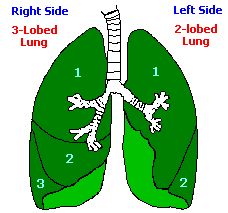 In recognizing that the left lung is smaller than the right lung (which provides room for the heart), let us conjecture that this is due to some past earlier developmental sequence just as we find the 1-layer, 2-layer, 3-layer sequential development of the 3 primordial germ layers (Ectoderm- Mesoderm- Endoderm) in primitive to more complex organisms. Hence, difference in size (dimorphism) as well as a two/ or three/ prominence may provide another link towards understanding developmental processes. Does this mean that the recurring smallness of the female to the male in many species indicates that females came before the male in terms of species-specific evolutionary development during particular environmental circumstances? | |
Date of Origination: Friday, 17-Feb-2017... 05:41 AM
Date of initial posting: Wednesday, 08-March-2017... 10:41 AM Updated posting: Friday, 6-April-2018... 12:54 PM